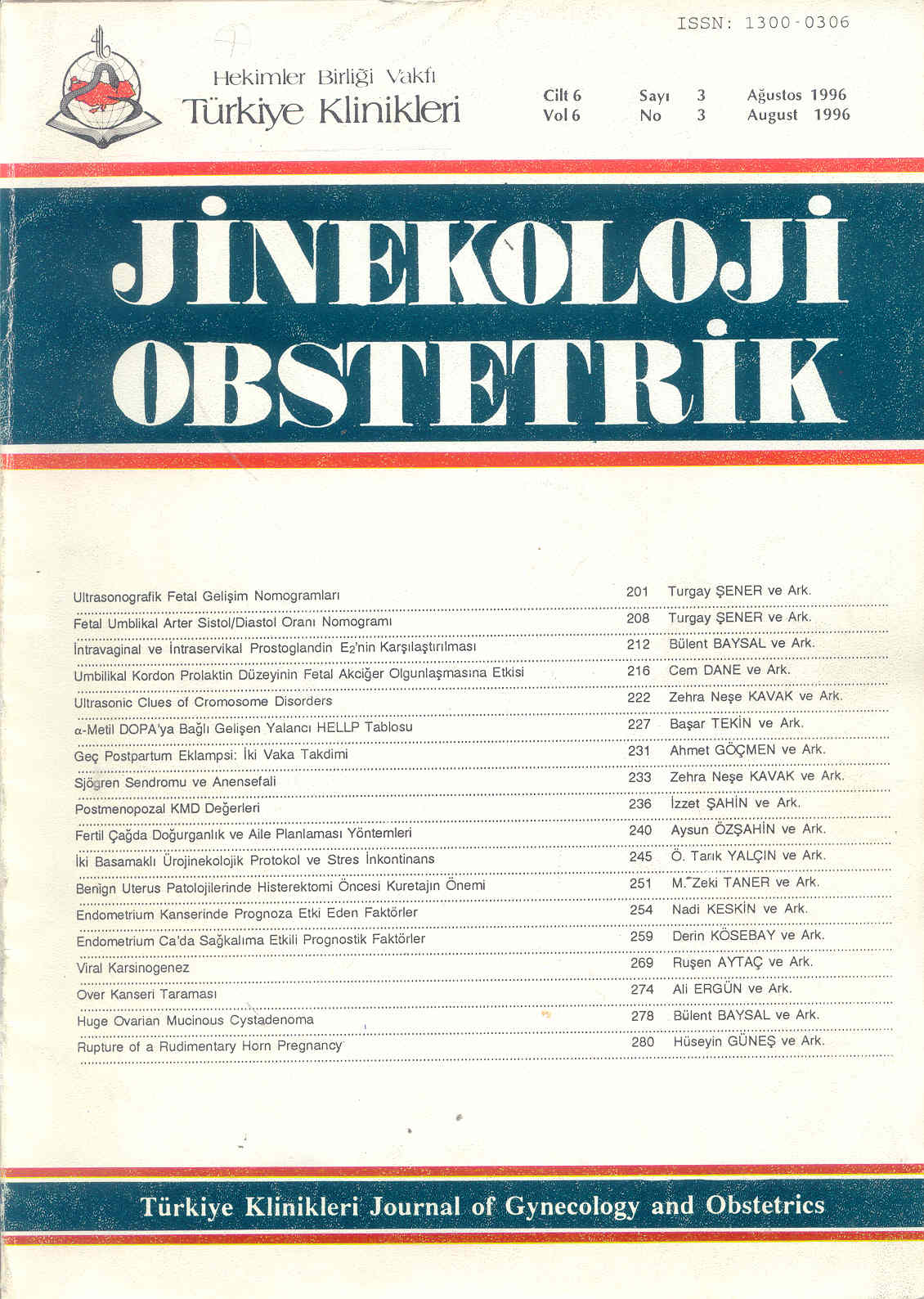Open Access
Peer Reviewed
ARTICLES
3197 Viewed1227 Downloaded
Evaluation Of Bone Mineral Density With Dual Photon Absorbsiometri In Postmenomopausal Women
Postmenopozal Kadınlarda Dual Foton Absorbsiometri ile Kemik Mineral Dansitesi Değerleri
Turkiye Klinikleri J Gynecol Obst. 1996;6(3):236-9
Article Language: TR
Copyright Ⓒ 2025 by Türkiye Klinikleri. This is an open access article under the CC BY-NC-ND license (http://creativecommons.org/licenses/by-nc-nd/4.0/)
ÖZET
Amaç: Dual foton absorbsiometri (DFA) ile yapılan kemik mineral dansitesi (KMD) ölçümlerinin Türk postmenopozal kadınları için ortalama değerlerini araştırmak ve KMD düzeylerini etkileyen faktörleri belirlemek. Çalışmanın yapıldığı yer: Gazi Üniversitesi Tıp Fakültesi, Kadın Hastalıkları ve Doğum Anabilim Dalı. Materyel ve Metod: Bu çalışmada, en az 6 aydır menopozda olan 228 kadının KMD ölçümleri DFA ile yapıldı. Hastalarda, kemik dansitesini etkileyen faktörleri saptamak amacıyla yaş, menopoz yaşı, menopoz süresi, menarş yaşı, sigara kullanımı, hormon replasman tedavisi, tahsil, egzersiz, boy, vücut ağırlığı gibi klinik parametreler kaydedildi ve multipl regresyon analizleri ile incelendi. Bulgular: Olguların ortalama yaşı 49.14 ± 6.74, ortalama menopoz yaşı ise 44.68 ± 5.66 idi. Tüm hastalar değerlendirildiğinde ortalama KMD değeri 0.937 ± 0.155 g/cm2 bulundu. Çeşitli klinik parametreler multipl regresyon analizleri ile incelendiğinde KMD üzerinde etkili olan en önemli faktörün menopoz süresi olduğu gösterildi. Sonuç: Bu çalışmada, Türk postmenopozal kadınlarında DPA ile yapılan KMD ölçülerin ortalamasının gelişmiş ülkelere göre daha düşük olduğu ve KMD'yi etkileyen en önemli klinik faktörün menopoz süresi olduğu gösterildi.
Amaç: Dual foton absorbsiometri (DFA) ile yapılan kemik mineral dansitesi (KMD) ölçümlerinin Türk postmenopozal kadınları için ortalama değerlerini araştırmak ve KMD düzeylerini etkileyen faktörleri belirlemek. Çalışmanın yapıldığı yer: Gazi Üniversitesi Tıp Fakültesi, Kadın Hastalıkları ve Doğum Anabilim Dalı. Materyel ve Metod: Bu çalışmada, en az 6 aydır menopozda olan 228 kadının KMD ölçümleri DFA ile yapıldı. Hastalarda, kemik dansitesini etkileyen faktörleri saptamak amacıyla yaş, menopoz yaşı, menopoz süresi, menarş yaşı, sigara kullanımı, hormon replasman tedavisi, tahsil, egzersiz, boy, vücut ağırlığı gibi klinik parametreler kaydedildi ve multipl regresyon analizleri ile incelendi. Bulgular: Olguların ortalama yaşı 49.14 ± 6.74, ortalama menopoz yaşı ise 44.68 ± 5.66 idi. Tüm hastalar değerlendirildiğinde ortalama KMD değeri 0.937 ± 0.155 g/cm2 bulundu. Çeşitli klinik parametreler multipl regresyon analizleri ile incelendiğinde KMD üzerinde etkili olan en önemli faktörün menopoz süresi olduğu gösterildi. Sonuç: Bu çalışmada, Türk postmenopozal kadınlarında DPA ile yapılan KMD ölçülerin ortalamasının gelişmiş ülkelere göre daha düşük olduğu ve KMD'yi etkileyen en önemli klinik faktörün menopoz süresi olduğu gösterildi.
ANAHTAR KELİMELER: Menopoz, kemik mineral dansitesi, dual foton absorbsiyonları
ABSTRACT
Objective: Evaluation of mean bone mineral density (BMD) of Turkish postmenopausal women with Dual Photon Absorbsiometri (DPA) and detection of clinical parameters which affect bone density. Institution: Faculty of Medicine, Gazi University, Department of Obstetrics and Gynecology, Ankara, Turkey Material and Methods: BMD measurements of 228 postmenopausal women, who were amenorrheic for at least 6 months, were performed with DPA. In order to detect the clinical variables which affect the BMD; age, age at menopause, months since menopause, smoking habits, hormone replacement therapy, education level, exercise, heigher and weight were recorded in a questionnaire and evaluated with multipl regression analysis. Findings: The mean age of the patients was 49.14 ± 6.74 years, were as the mean age at menopause was 44.68 ± 5.66 years. Mean BMD for all patients was 0.937 ± 0.155 g/cm2. Evaluation of the clinical variables with multipl regression analysis revealed that, most significant factor affecting BMD was months since menopause. Conclusion: The mean BMD measured with DPA in Turkish postmenopausal women, seems to be lower than developed countries and among various clinical parameters the most significant factor which contributes bone density is the duration of menopause.
Objective: Evaluation of mean bone mineral density (BMD) of Turkish postmenopausal women with Dual Photon Absorbsiometri (DPA) and detection of clinical parameters which affect bone density. Institution: Faculty of Medicine, Gazi University, Department of Obstetrics and Gynecology, Ankara, Turkey Material and Methods: BMD measurements of 228 postmenopausal women, who were amenorrheic for at least 6 months, were performed with DPA. In order to detect the clinical variables which affect the BMD; age, age at menopause, months since menopause, smoking habits, hormone replacement therapy, education level, exercise, heigher and weight were recorded in a questionnaire and evaluated with multipl regression analysis. Findings: The mean age of the patients was 49.14 ± 6.74 years, were as the mean age at menopause was 44.68 ± 5.66 years. Mean BMD for all patients was 0.937 ± 0.155 g/cm2. Evaluation of the clinical variables with multipl regression analysis revealed that, most significant factor affecting BMD was months since menopause. Conclusion: The mean BMD measured with DPA in Turkish postmenopausal women, seems to be lower than developed countries and among various clinical parameters the most significant factor which contributes bone density is the duration of menopause.
MENU
POPULAR ARTICLES
MOST DOWNLOADED ARTICLES





This journal is licensed under a Creative Commons Attribution-NonCommercial-NoDerivatives 4.0 International License.










